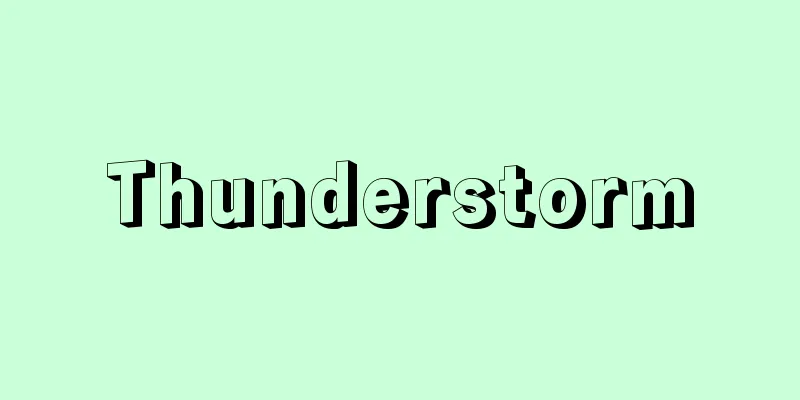Thunderstorm

|
Weather conditions in which lightning can be seen and thunder can be heard. Distant lightning can be seen but thunder cannot be heard. Therefore, the Japan Meteorological Agency defines the weather conditions at an observation point as described above. [Hiroo Misaki] The origin of lightningLightning occurs in cumulonimbus clouds, which are generated by strong updrafts. As a result of the interaction between the updrafts and precipitation particles (raindrops, ice crystals, hail, etc.) in a cumulonimbus cloud, separation of positive and negative electricity occurs in the initially electrically neutral cloud, and negative charges accumulate in the lower and middle layers of the cloud, and positive charges in the upper layers. When the accumulated positive and negative charges reach about 20 coulombs each, a lightning discharge occurs. The moment when a cumulonimbus cloud first produces a lightning discharge is called a lightning flash. After lightning flashes, the accumulation of electricity and neutralization by lightning flashes occur repeatedly, and at its peak, the frequency can reach several times per minute. Lightning does not occur with weak convection such as that of cumulus clouds. It requires a strong updraft. Depending on the cause, it is called heat lightning, boundary lightning (or frontal lightning), vortex lightning (low pressure lightning), etc., but in reality, these causes are often combined. Heat lightning occurs when the ground is strongly heated by solar radiation and cold air flows into the sky. This gives the moist air at the bottom strong buoyancy and causes it to rise, and the cloud top reaches the top of the troposphere, or the tropopause, a height of about 10 to 15 kilometers. It is a typical summer lightning. Boundary lightning occurs when warm air is suddenly pushed up by the intrusion of a cold front, and winter lightning belongs to this category. In winter, the temperature of the ground surface is already close to freezing, so lightning can occur even if the cloud top height is lower than in summer lightning. [Hiroo Misaki] Number of days with lightningThe number of days with thunderstorms per year is highest in low-latitude land areas, especially in South America and Africa, with some areas seeing nearly 200 days per year, followed by Southeast Asia. In Japan, over the five-year period from 1998 to 2002, Hokkaido had the fewest, with fewer than 10 days per year, while the Kanto, Kinki, and Kyushu regions had the most, with 10-30 days, and the Hokuriku region had the most, with 40-60 days. The reason for the high number of days with thunderstorms per year in Hokuriku is the prevalence of thunderstorms in the winter. For example, in Kanazawa, the number of days with thunderstorms in the six winter months reaches 60% of the annual number. [Hiroo Misaki] Structure of a thundercloudThe smallest unit of the convective structure that makes up a thundercloud is called a thunderstorm cell. In its early stages, a cell is about 5 kilometers in diameter and height, and an updraft occupies the entire area. Air is also drawn into the cell from the sides, so the updraft becomes stronger the closer it is to the cloud top. At its peak, the cell has a diameter of 10 to 20 kilometers, the cloud top reaches the tropopause, and there are parts where the updraft exceeds 10 meters per second. When a sudden rain shower begins, the ground becomes wet and cools, so the convection effect weakens. In the decaying stage, a weak downdraft covers the entire cell, and light rain continues on the ground. In order for the cells in the prime stage to continue without weakening, a mechanism is needed to constantly take in hot and humid air and maintain the unstable state of the atmosphere. When the conditions for thermal lightning are met at the front, a large, intense, and persistent cell is born. This is called a supercell. Looking at the cross section (left side of ), there is a strong moist updraft that penetrates from the bottom of the cloud on the moving side and moves diagonally upward and backward. Within it, water vapor condenses to rain or snow, releasing latent heat, which warms the air and further increases its buoyancy. The cloud that reaches the tropopause in this way flows out horizontally and forms the anvil of the thundercloud. At this altitude, the temperature can be as low as -50°C, so all the cloud particles are ice crystals. The descending current penetrates from the middle layer of the back of the cloud, passes under the ascending current, and passes through to the cloud base. When snow or hail that falls from the sky passes through this descending area, some of it evaporates, cooling the air and further helping it to descend. A part of the descending current that has passed through the cloud base moves in the direction of the cloud's movement, which is the gust of cool air that is often experienced during thunderstorms. In the mature cells, the convective system consisting of ascending and descending currents is maintained for a while by this cycle of condensation and evaporation. The life span of a normal cell is less than an hour. As these thunderstorm cells alternate within a single thundercloud, the overall duration averages 2 to 3 hours, but can exceed 10 hours. During this time, if it is boundary lightning, it moves along with the front. Even heat lightning moves according to upper-level winds and the terrain. Its movement speed is usually several tens of kilometers per hour. In the Kanto region, heat lightning that occurs in the mountainous areas in the northwest often moves out into the plains and moves southeast. [Hiroo Misaki] Charge generation mechanism in thundercloudsWhen measuring the distribution of electric charges in a thundercloud, it is found that positive charges are distributed in the upper part of the cloud, and that the same amount of negative charges are distributed from the middle to the lower part of the cloud. This was known from balloon observations made by GC Simpson and others in the UK in the late 1930s, and has since been largely accepted by many other observations made around the world. Simpson also found that there are small areas near the base of the cloud where positive charges accumulate, which he calls pocket charges. It is more convenient to indicate the average location where positive and negative charges accumulate in a cloud in terms of temperature altitude rather than meter altitude. In the troposphere, the temperature decreases at a nearly constant rate as you go higher, so there is a rough correspondence between meter altitude and temperature altitude once the ground temperature is determined. If the location of the electric charge is indicated in meter altitude, the value will vary depending on the latitude and season of the observation point, but if it is indicated in temperature altitude, the value will be almost constant. To summarize the results up until the beginning of the 2000s, the main positive charges are found to be located above an altitude of approximately -30°C, while the negative charges are located below that, with their centers located at an altitude of around -15°C (right side of ). The amount of electricity is estimated to be roughly equal for both positive and negative charges, at 10 to 40 coulombs. Note that an altitude of -30°C corresponds to about 9 kilometers in mid-latitude summer, but about 3 kilometers in winter. For example, it has been confirmed that this is actually the case with lightning in the Hokuriku region in winter. Observations have revealed that positive and negative charges are separated in thunderclouds, with the positive charges distributed at the top and the negative charges at the bottom, but there is still no definitive theory as to how this separation of charges occurs in clouds that are initially neutral. As mentioned before, there are strong updrafts in thunderclouds, and the separation of charges occurs in these regions. Small precipitation particles such as ice crystals and snowflakes are blown up, and large precipitation particles such as hail fall at a faster rate than the updrafts. Therefore, if we could understand the mechanism by which small precipitation particles become positively charged and large precipitation particles become negatively charged, it would explain how electricity is generated in thunderclouds. At altitudes where positive and negative charges accumulate, as mentioned before, the temperature is much lower than the freezing point, so precipitation particles cannot exist in the form of unfrozen raindrops. Therefore, the charging mechanism must be related to ice crystals or hail. Various processes have been considered, such as the growth process of snow, friction between ice crystals and hail, and polarization due to the temperature gradient in the ice, but the most likely one is the "Icing Charge Generation Theory" proposed by Takahashi Tsutomu (1935-). According to this theory, charges are generated when hail and ice crystals collide, and when the surrounding temperature is below -10°C, the hail becomes negatively charged and the ice crystals become positively charged, and when the temperature is above -10°C, the polarity is reversed. Even this theory does not fully explain the charging mechanism of thunderclouds. [Hiroo Misaki] Lightning Discharge MechanismLightning discharges are electric currents that flow over a distance of several kilometers in an instant. The first question was how such long-distance discharges can occur. Since lightning is a lightning discharge between the cloud and the ground, unlike lightning discharges inside the clouds, the discharge path can be photographed. The details of the discharge mechanism were first clarified in lightning. The special camera used in this research is called a Boys camera after its inventor, CV Boys of England. In this camera, the lens rotates at high speed on a single circumference relative to the film. When lightning is photographed with this camera, the image of the streamer (a linear flash of light) is shifted due to the time difference compared to that of a still camera. By reading this, not only the shape and position of the streamer but also the speed at which it extends can be determined. is a model of this. During the lightning strike that appears to be instantaneous to the naked eye, several lightning strokes are repeated at intervals of about 0.05 seconds. This is called multiple lightning strokes. Some lightning strikes consist of a single strike, but this is only about one in four cases; most are three or four multiple strikes, with the total duration of these strikes being about 0.3 seconds. Sometimes there are as many as ten or more multiple strikes. Looking more closely, we can see that each stroke consists of a precursor that travels from the cloud to the ground, followed immediately by a return stroke. The precursor stroke is understood to guide the negative charge in the cloud and create an ionized path in the atmosphere. In particular, the precursor of the first stroke has a special structure, as shown in , and is called a step-like precursor. In this precursor, streamers extend one after another from the cloud base at 50 microsecond intervals and stop. At this time, the subsequent streamers stop at a point 50 meters further from the stop point of the previous streamer. This is a necessary process to break the insulation of the air and open up a discharge path. When the step-like precursor approaches the ground, the last few meters to tens of meters are combined with the streamers emitted from the ground, and at that moment, a very bright streamer follows the discharge path opened by the precursor from the ground to the cloud. This is the return stroke, and a large current of tens of thousands of amperes flows in an instant. In this way, the negative charge at the bottom of the cloud is neutralized. The precursors of the second and subsequent strokes lead the negative charges further up in the cloud toward the ground. At this time, the ionization state of the discharge path of the first stroke has not yet completely disappeared, so they follow exactly the same discharge path. And at this time, unlike the step-like precursor of the first stroke, they reach the ground without stopping along the way. This is called an arrow-shaped precursor. In natural lightning, the precursor starts at the cloud base and heads toward the ground, as just described, but in lightning strikes on prominent structures such as skyscrapers, the precursor starts at the top of the building and heads toward the cloud base. This type of lightning is called triggered lightning, and it should be noted that this is the reason why the probability of lightning striking such structures is significantly higher. The duration of a return stroke is about 60 microseconds, but sometimes it can last 1,000 to 10,000 times longer (the shadow line following the third stroke in ). During this time, a current of 100 to 1,000 amperes flows continuously. This type of lightning stroke is what causes fires, and is called "hot lightning discharge," accounting for 20 to 25% of all lightning strokes. In contrast, lightning strokes that do not involve the continuous current mentioned above only cause mechanical destruction and do not leave any burns, so they are also called "cold lightning discharge." The above are the standard characteristics of summer lightning, but the characteristics of winter lightning were found to be quite different by Toshio Takeuchi (1931- ) and others at the Nagoya University Research Institute of Atmospheric Electricity (then) in the late 1970s and 1980s, and the same was confirmed for winter lightning in Northern Europe. In contrast to summer lightning, where the negative charge of the cloud falls to the ground, in winter lightning, many strikes are positive charges falling from the cloud to the ground. This is because the wind speed near the cloud top in winter thunderclouds is considerably faster than in the lower layers, so the axis connecting the centers of positive and negative charges is tilted forward in the direction of the thundercloud's movement. The discharge that starts from the positive charge at the top of the lightning reaches the ground directly and becomes a lightning strike because there is no negative charge directly below it. In addition, the majority of lightning strokes include continuous current, i.e. "hot lightning discharges". Furthermore, the amount of electricity and current neutralized in one discharge are greater than in summer lightning. As mentioned earlier, winter lightning is feared in the Hokuriku region and is known as a "single flash of lightning" because the cloud tops are low and it is not immediately obvious that they are thunderclouds, and they often cause great damage. [Hiroo Misaki] Lightning prevention tipsThe safest place to avoid lightning is inside a box completely surrounded by grounded metal plates or mesh. This is called a Faraday cage, and although it theoretically guarantees complete safety, it is not possible in real life. Practically speaking, the closest thing to this is a reinforced concrete building, train, or automobile, and you will be safe inside one of these. A lightning rod has a cone shape with a 60 degree opening (called the protection angle) from the vertical axis at its apex, and this is considered a safe area, but this guarantee is not absolute. The closer you are to the lightning rod, the safer you will be, so the protection angle for lightning rods for dangerous objects such as oil tanks is set to 45 degrees or less. Even if you are inside a house, it is important not to go near electric light lines, televisions, telephones, etc., and if you live in a wooden house, avoid leaning against windows or walls. Even if you are not directly struck by lightning, if lightning strikes nearby, a large induced current can flow in nearby power lines, so it is a good idea to unplug electrical appliances. Being caught in lightning outdoors poses many problems. If there is no shelter nearby, it is essential to get as low as possible in a cave or depression. Do not hold an umbrella or other metal object above your neck. Forests can also be a place of shelter, but you should avoid areas near large trees, and it is best to stay several meters away from individual trees. Leaning against the trunk of a tree is the most dangerous thing to do. Mountain peaks and ridges are not only extremely dangerous, but are often rocky, so special care is required. Rocky areas have high electrical resistance, so lightning current is not absorbed at the point of lightning, but sweeps over the surface of the rocks in the surrounding area. This can lead to many deaths and injuries in groups of climbers with a single lightning strike. Creeping discharges can jump over small cracks in the rocks, so in such places, even if the area is a depression, if the upper half of the body is exposed, it will be in the path of the current, making it even more dangerous. It is best to think of a large rock as a lightning rod and lower your posture so that you can see the top of the rock at an elevation angle of 45 degrees or more. However, you should not get too close to the rock or lean against it. In any case, it is important to detect lightning as soon as possible when in the mountains. To do this, pay attention to thunderstorm forecasts and be careful of noise on your radio receiver. If the area is covered with clouds and hail begins to fall, you should assume that danger is near. The average number of deaths from lightning strikes in Japan per year was about 35 in the 1960s, but gradually decreased to about 5 in the 1990s (Police White Paper). In the United States, the average number of deaths from lightning strikes between 1959 and 1994 dropped from about 90 to about 50. Painful burns are noticeable on the bodies of people struck by lightning, but burns from lightning heal in a short time and are not the cause of death. The cause of death is paralysis of the respiratory system and heart due to the current flowing through the body. When a person is struck by lightning, both breathing and the heart stop, so if left untreated, they will soon die. It is said that in many cases the person can be resuscitated by administering artificial respiration and cardiac massage as soon as possible. [Hiroo Misaki] The meaning of thunder and various nationsPhenomena such as thunder, lightning, and thunderbolts, along with other unique natural phenomena such as earthquakes, solar eclipses, lunar eclipses, meteors, and rainbows, are given various meanings by peoples all over the world. These phenomena occur far beyond the reach of human power, and their occurrence is difficult to predict, and they do not necessarily fit within the framework of everyday human knowledge. Lightning and earthquakes in particular are overwhelming forces that can even take human lives, and for that reason they particularly interest humans. By providing some kind of background to these phenomena, each people has tried to incorporate them into the framework of knowledge and, by making them explainable, to eliminate the fear of nature. The meaning of thunder varies among different ethnic groups, and beliefs about thunder vary from one ethnic group to another depending on the place that thunder occupies in the worldview and cosmology of each ethnic group. Among the Negrito people of the Malay Peninsula, thunder is considered to be an expression of the displeasure or anger of God. God is said to express his anger toward certain human actions, such as killing people, committing incest, teasing animals, laughing at one's own face in a mirror, and burning leeches that have sucked blood to be offered to God, and this anger reaches earth from heaven in the form of thunder. In order to appease the anger of God, it is necessary to offer blood to God, and when the thunder is particularly violent, prayers and blood are offered to God to stop the thunder to avoid the danger of being struck by lightning. It is believed that if this is not done, the lightning will knock down trees, which will result in floods and people being swept away. A similar belief is found among the Penan and Gaju people of Borneo, but a more generalized belief linking thunder with heavenly gods is found all over the world. For example, Zeus, the supreme god in Greek mythology, also had the characteristics of a thunder god, and his weapons were thunder and lightning. The god Indra in Indian mythology, which is of the same Indo-European language family as Greek mythology, and the god Thor in Norse mythology were also thunder gods, and also used thunder as their weapon. Furthermore, Shangdi, the supreme god of ancient China, also expressed his divinity through thunder. The Indian tribes of Mexico also believed in beings such as thunder gods or lightning gods. There is a custom among various ethnic groups of regarding certain stones and trees as thunder stones and thunder trees, respectively, as sacred. There is also a widespread belief that thunder is associated with birds. The Tlingit people, a Native American people of North America, believe that thunder is caused by the flapping of the wings of the thunderbird. They believe that there is a large lake on the thunderbird's back, and therefore the flapping of the thunderbird's wings causes heavy rain to fall along with thunder. The Mandan and Hidatsa people, also Native Americans of North America, also believe that thunder is caused by the flapping of the wings of the thunderbird, and the Miwok people consider a type of giant jay to be the thunderbird. The Orochi people of Siberia also believe that the guardian spirit of the shaman is the thunderbird. It is believed that the shaman enters a state of tranquility, and the guardian spirit of the thunderbird transforms into the shaman and flies into the sky, and that the shaman can cure the illness by recovering the soul of the sick person who has been taken by an evil spirit in the spirit world. As mentioned above, people all over the world attach various meanings to lightning, and the forms these meanings take vary from one ethnic group to another. However, at the root of all of this is a commonality in which they all seek to provide some sort of explanation for the phenomenon of lightning that is beyond the power of humans. [Hiroyuki Kurita] Lightning and FolkloreBefore lightning was considered a natural phenomenon, people believed it to be the violent roaming of a god in the heavens, and when it struck, people would chase it, trying to capture it as it turned into a thunder beast. In Okayama Prefecture, the damage caused by lightning was so severe long ago that when a prayer was offered to ward off lightning, lightning struck a pine tree in the middle of a sudden shower, and a monster began to roam about. A monk caught it, made it promise never to harm anyone again, and then released it. It is said that thanks to this, the village has never been hit by lightning or other such attacks. According to the records of the classics, in ancient times it was believed to appear in the form of a child or a snake, and later, when the belief in a spirit centered on Kitano Tenjin Shrine, which enshrines Sugawara no Michizane, spread, the belief in the thunder god was combined with this and absorbed into the belief in Tenjin. However, thunder has always been deeply connected to agricultural life, and the idea that thunder causes growing rice to sprout is a nationwide belief. The word inazuma for lightning probably means "husband of rice." Another similar belief is that if you save beans from the New Year (Setsubun) and eat them when thunder first rumbles, you will avoid summer sickness. In some regions, thunder in winter means a good harvest, and in other regions green bamboo is stretched over rice fields where lightning has struck to worship the rice. In Ibaraki Prefecture, when thunder rumbles during the rice seedling season, split bamboo is struck to drive the rice away. This is called kandachioi (chasing the gods), and it evokes a simple image of a god's manifestation. People's reactions to these spirits, which often bring about disasters while bringing about good harvests, are often contradictory. For example, in one place it is said that "if thunder rumbles on New Year's Day, rice and millet will ripen," while in another place it is said that "if there is thunder on New Year's Day, there will be man-made disasters." There were various ways to ward off thunder, such as going into a mosquito net, burning incense, or making one foot of straw sandals and throwing them away, but chanting "Kuwabara Kuwabara" was one of them, and this spell was already seen in the Noh song "Dojoji" and the Kyogen play "Kaminari." The origin of this phrase is often explained as coming from the name of the place where Sugawara Tenjin's territory was located, as explained in "Natsuyama Zatdan" by Ono Takanao in the mid-Edo period, but the exact origin is unknown. [Tatsuo Hagiwara] "Sky Lightning" by Jun Kanehara (1944, Kawade Shobo)" ▽ "Changes in Belief in the Thunder God" (included in "The Complete Works of Yanagita Kunio 9", 1962, Chikuma Shobo)" ▽ "The Science of Clouds and Lightning" by Nagaharu Mago (1969, NHK Publishing)" ▽ "The Science of Lightning" by Hisanao Hatakeyama (1970, Kawade Shobo Shinsha)" ▽ "The Myth of Thunderclouds" by Dairoku Harada (1978, Sanichi Shobo)" ▽ "Sky Lightning - On the Radio Wave Radiation of Lightning" by Kazuo Sao (1981, Seizando Shoten)" ▽ "The Physics of Clouds - From Cloud Particle Formation to Cloud Movement" by Takahashi Takashi (1987, Tokyodo Publishing)" ▽ "Lightning Discharge Phenomenon" by Toshio Takeuchi (1987, Nagoya University Press)" ▽ "Lightning - The Damage and Countermeasures" edited by Uenozono Chikasa (1988, Kyoikusha)" ▽ "The Science of Lightning" by Aiba Mitsugu (1990, Corona Publishing)" ▽ "Lightning and Surges - From How They Occur to Damage Prevention" by Hashimoto Nobuo (1991, Denki Shoin)" ▽ "The Mysterious Science of Lightning - The Very Basics of High Voltage and Discharge" by Hayami Toshiyuki (1996, Kodansha)" ▽ "Atmospheric Electricity" edited by Kitagawa Shinichiro, Kawa Zenichiro, Miura Kazuhiko, and Michimoto Koichiro (1996, Tokai University Press)" ▽ "The Science of Winter Lightning" by Michimoto Koichiro (1998, Corona Publishing)" ▽ "Lightning Strikes Here - New Common Sense for Protecting Yourself from Lightning" by Okano Daisuke (1998, Ohmsha)" ▽ "The Science of Lightning and Thunderclouds - How to Protect Yourself from Lightning" by Kitagawa Shinichiro (2001, Morikita Publishing) " ▽ "Thoughts and Beliefs on the Thunder God and Dragon God - A Comparative Study of Japanese and Chinese Language and Culture" by Li Junyang (2001, Akashi Shoten)" ▽ "The Drama of Heaven and Earth: Amazing Thunder Research" edited by Kitagawa Shinichiro and written by Kako Satoshi (2001, Komine Shoten)" ▽ "Introduction to Atmospheric Electricity, edited by the Japanese Society of Atmospheric Electricity (2003, Corona Publishing)" ▽ "Lightning Protection and Grounding Manual - The Achilles Heel of the IT Society" by Peter Hasse and Johannes Wisinger, translated by Kato Kojiro and Mori Harumoto (2003, Tokyo Denki University Press)" ▽ "Lightning" by Nakaya Ukichiro (Iwanami Shinsho) [References] | | | | | | | | | | | | | |Lightning rod| | | | | | |©Shogakukan "> Supercell structure and charge distribution in thunderclouds […] ©Shogakukan "> Mechanism of lightning strike (Figure B) This painting depicts three women panicking during a sudden thunderstorm. They can be seen closing the shutters, hanging mosquito nets to ward off lightning, and lighting incense sticks. On the bridge, people can be seen rushing back and forth. "Ryōgoku Niwaka Yudachi" (Sudden Shower at Ryōgoku), triptych by Utagawa Kunisada (Toyokuni III), 1852 (Kaei 5), owned by the National Diet Library . Shower Source: Shogakukan Encyclopedia Nipponica About Encyclopedia Nipponica Information | Legend |
|
電光が見え、雷鳴が聞こえる天気状態。遠方の雷は、電光が見えても雷鳴は聞こえない。そこで気象庁では、観測地点の天気状態を表現するにあたって冒頭のように規定している。 [三崎方郎] 雷の成因雷は強い上昇気流によって発生した積乱雲に伴っておこる。積乱雲の中では上昇気流と降水粒子(雨滴、氷晶、あられなど)の相互作用の結果、初めは電気的に中性であった雲の中で正負の電気の分離がおこり、雲の下層から中層にかけて負電荷が、上層に正電荷が蓄積される。正電荷、負電荷の蓄積量がそれぞれ20クーロンほどに達すると、電光放電がおこる。積乱雲が初めて電光放電を生じた時点を発雷という。発雷後も電気の蓄積と電光放電による中和の繰り返しがおこるが、最盛期にはその頻度は1分間に数回にも達する。 雷は積雲程度の弱い対流では発生しない。強い上昇気流が必要である。それをおこす原因の違いによって熱雷、界雷(または前線雷)、渦雷(低気圧雷)などの呼び名があるが、実際にはこれらの原因が複合する場合も多い。熱雷がおこるのは、日射によって地面が強く熱せられると同時に、上空に寒冷な空気が流入した場合である。これによって下層の多湿な空気が強い浮力を与えられて上昇し、雲頂が対流圏の頂部、すなわち圏界面とよばれる高さ約10~15キロメートル近くまで達することによっておこる。夏季の雷の典型である。界雷は寒冷前線の突入によって暖気が急激に押し上げられた場合で、冬季の雷はこれに属する。冬季は地表面の温度がすでに氷点に近いので、雲頂高度は夏季雷より低くとも発雷する。 [三崎方郎] 雷の発生日数年間雷雨日数の世界分布は、低緯度の陸地、とくに南アメリカとアフリカでもっとも多く、年間200日に近い地方がある。東南アジアがこれに次ぐ。日本では、1998(平成10)~2002年の5年間をみると、北海道地方各地では年間10日以下でもっとも少なく、関東、近畿、九州地方で10~30日、北陸地方では40~60日ともっとも多い。北陸で年間の雷日数が多いのは冬季の雷が多いためである。たとえば金沢では、冬季6か月間の雷日数は年間のそれの60%にも達している。 [三崎方郎] 雷雲の構造雷雲を構成する対流構造の最小単位を雷雨細胞(セルcell)という。幼年期の細胞は直径も高さも5キロメートルほどで、上昇気流が全域を占める。細胞の側面からも空気が細胞に吸い込まれるので、上昇気流は雲頂に近いほど強くなる。最盛期になると細胞の直径は10~20キロメートルとなり、雲頂は圏界面に達し、上昇気流は毎秒10メートルを超える部分も出てくる。驟雨(しゅうう)が降り始めると、地面がぬれて冷えるので、対流作用は衰えてくる。消滅期には弱い下降気流が細胞の全域にわたり、地上では弱い雨が続く。 最盛期の細胞が衰弱せずに持続するためには、高温多湿な空気を絶えず取り入れて、大気の不安定状態を持続する仕組みが必要である。前線に熱雷発生の条件が加わると、大形で激しく、かつ持続性のある細胞が生まれる。これを超大細胞(スーパーセルsuper cell)という。断面図(の左)でみると、雲の進行側の底面から侵入し、斜め上後方に向かう湿った強い上昇流がある。その中では水蒸気が凝結して雨や雪になるので潜熱が放出され、それによって空気は暖められるため、さらに浮力を増す。こうして圏界面に達した雲は水平に流れ出て雷雲の鉄床(かなとこ)部を形成する。この高度では気温が零下50℃にもなるので、雲粒はすべて氷晶である。下降流は雲の背面の中層から侵入し、上昇流の下側を通って雲底に抜ける。上空から落ちてきた雪やあられがこの下降域を通過するとき、一部が蒸発するので空気を冷却し、その下降をいっそう助ける。雲底に抜けた下降流の一部は雲の進行方向に向かうが、これが雷雨の際によく経験される一陣の涼風である。最盛期の細胞の中では、このように凝結と蒸発のサイクルによって上昇流と下降流よりなる対流系がしばらくの間保持されるのである。 通常の細胞の寿命は1時間に満たない。一つの雷雲ではこうした雷雨細胞が交互に発生するので、全体としての継続時間は平均2~3時間であるが、10時間を超えることもある。この間、界雷ならば前線の進行につれて移動する。熱雷であっても上層風や地形によって移動する。その速度は普通毎時数十キロメートルである。関東地方では北西の山岳部に発生した熱雷は平野部に出て南東に進行することが多い。 [三崎方郎] 雷雲内の電荷発生機構雷雲内の電荷の分布を測定してみると、雲の上部には正電荷が分布し、雲の中部から下部にかけてほぼ同量の負の電荷が分布していることがわかる。これは、1930年代の終わりにイギリスのシンプソンG. C. Simpsonらが行った気球観測で知られたことであるが、その後、世界各地で行われた多くの観測によっても大筋では異論なく認められている。シンプソンはなお、雲底の近くに正電荷が蓄積されている小領域があることもみいだしているが、これをポケット電荷とよんでいる。雲の中で正負の電荷が蓄積される平均的な位置は、メートル高度で示すより、温度高度で示したほうが都合がよい。対流圏の中では気温はほぼ一定の減率で上空ほど低温になっているので、地上気温が決まればメートル高度と温度高度との間にはいちおうの対応がある。電荷の位置をメートル高度で示すと、観測点の緯度や季節によってまちまちの値になってしまうが、温度高度で示すとほぼ一定の値になるのである。2000年代当初までの結果をまとめると、おもな正電荷はおよそ零下30℃の高度より高いところに、負電荷はそれより下に分布していて、その中心は零下15℃あたりの高度に位置している(の右)。そしてその電気量は正負それぞれほぼ等量で、10~40クーロンと推定されている。なお、零下30℃の高度といえば、中緯度の夏季であれば約9キロメートルに相当する。しかし冬季なら約3キロメートルとなる。たとえば冬の北陸の雷でも実際にそうなっていることが確かめられている。 雷雲の中では正負の電荷が分離して、正は上部に、負は下部に分布しているということが観測によってわかったが、初め中性であった雲の中でどのようにしてこのような電荷の分離が行われるのかについては、いまだに確定した説がない。前にも述べたように、雷雲の中では激しい上昇気流があり、しかも電荷の分離はその領域で行われている。氷晶や雪片などの小さな降水粒子は吹き上げられ、あられなどの大粒な降水粒子で、上昇気流より大きい落下速度をもつものが落ちてくる。したがって、小さな降水粒子が正に、大きな降水粒子が負に帯電するような仕組みが解明されれば、雷雲の中でどうして電気が発生するのかが説明されるはずである。 正電荷や負電荷が蓄積される高度では、前にも述べたように気温が氷点よりかなり低いので、降水粒子は未凍結の雨滴の状態では存在しえない。したがってその帯電機構はいずれ氷晶とかあられに関係したものである。そこで、これまでに、雪の成長過程、氷晶とあられの間の摩擦、氷の中での温度勾配(こうばい)による分極作用など、さまざまな過程が考えられてきたが、そのなかで現在もっとも有力視されているのが高橋劭(つとむ)(1935― )が提唱した「着氷電荷発生説」である。この説によると、あられと氷晶とが衝突する際に電荷が生成され、周辺の気温が零下10℃以下のときにはあられが負に、氷晶が正に帯電し、零下10℃以上ではその極性が反転するという。この説にしても雷雲帯電機構のすべてを説明するまでには至っていない。 [三崎方郎] 電光放電機構雷放電は瞬時に数キロメートルの長さにわたって大電流を流す放電である。このような長距離にわたる放電がいかにしておこりうるかが第一の疑問であった。落雷は雲と地面の間の電光放電であるので、雲の中の放電と違って放電路の写真観測ができる。そこで放電機構の詳細はまず落雷について明らかになった。この研究に用いられる特殊カメラは、考案者であるイギリスのボイスC. V. Boysの名をとってボイスカメラとよばれているが、このカメラではレンズがフィルムに対して一つの円周上を高速回転している。それでこのカメラで電光を撮影すると、ストリーマーstreamer(線状の閃光(せんこう))の影像が静止カメラのそれと比べて時間差によるずれを生ずるので、それを読み取ればストリーマーの形や位置ばかりでなく、それが延びる速度を求めることができる。はこれをモデル化して描いたものである。肉眼では一瞬に見える落雷の間に、数個の雷撃が約0.05秒の間隔で繰り返されている。これを多重雷撃という。落雷のなかには1回の雷撃で終わるものもあるが、それは全体の4分の1にすぎず、普通は3回か4回の多重雷撃で、これらを含む全体の継続時間は約0.3秒である。ときには10回以上という多重雷撃もある。 さらに細かくみると、各雷撃はそれぞれ雲から地面に向かう前駆と、その直後におこる帰還雷撃よりなっていることがわかる。前駆雷撃は雲の中の負電荷を導き、かつ電離された道筋を大気中につくりだすものと理解されている。とくに第1雷撃の前駆はにみられるように特殊な構造をもっており、階段状前駆とよばれる。この前駆では、雲底から50マイクロ秒の時間間隔でストリーマーが次々と延び出して停止する。このとき、あとのストリーマーは直前のストリーマーの停止点よりさらに50メートル延長した点で停止する。これは空気の絶縁を破壊して放電路を開拓するために必要な過程なのである。階段状前駆が地面に近づくと、最後の数メートルから数十メートルは地面から放たれたストリーマーで結合し、その瞬間強い明るさのストリーマーが、前駆によって開拓された放電路をたどって大地から雲に向かう。これが帰還雷撃で、瞬間的には数万アンペアの大電流が流れている。こうして雲の下部の負電荷が中和される。第2雷撃以下の前駆は雲の中のさらに上部の負電荷を導いて地面に向かう。このときには第1雷撃の放電路の電離状態がまだ完全には消滅していないので、それとまったく同じ放電路をたどる。そしてこのときは第1雷撃の階段状前駆のように途中で停止することなく地面まで達する。これを矢形前駆という。自然の落雷では前駆はいま述べたように雲底から始まって地面に向かうが、超高層ビルのように著しく突出した構造物に対する落雷では、前駆はビルの先端から始まって雲底に向かう。このような雷撃をトリガード雷撃triggered lightning(触発された雷撃)とよぶが、このような構造物に落雷する確率が著しく高くなる理由として注意すべきである。 帰還雷撃の継続時間は60マイクロ秒程度であるが、ときとしてその1000倍から1万倍も長い時間にわたることがある(の第3雷撃に続く影線)。この間、100~1000アンペアの電流が連続して流れている。落雷で出火するのはこの種の雷撃であって、「熱い雷放電」とよばれ、落雷総数のうちの20~25%を占めている。これに対して、前記の連続電流を含まない雷撃では、機械的な破壊を伴うだけで、焼痕(しょうこん)を残すことがないので「冷たい雷放電」ともよばれる。 以上は夏の雷の標準的な落雷特性であるが、冬の雷の特性はこれとかなり異なることが、1970年代後半から1980年代にかけて名古屋大学空電研究所(当時)の竹内利雄(1931― )らによって発見され、その後北欧の冬雷についても同じことが確かめられている。夏の落雷は雲の負電荷が地面に落ちるのに反して、冬の雷では多くの落雷で正電荷が雲から大地に落ちている。これは、冬の雷雲では雲頂近くの風速が下層と比べて相当に大きいため、正負の電荷の中心を連ねる軸が雷雲の進行方向に前傾していることに由来する。雷の上部の正電荷から始まった放電は、直下に負電荷がないために直接地面に到達して落雷になる。また連続電流を含む雷撃すなわち「熱い雷放電」が大多数を占める。さらに1回の放電で中和される電気量も電流も夏の雷に比べて大きい。冬の雷は前にも記したように、雲頂が低く一見して雷雲であると気づかないこともあるうえ、しばしば大きな被害をもたらすので、北陸では「一発雷」といわれて恐れられている。 [三崎方郎] 避雷の心得落雷を避けるうえで確実に安全な場所は、接地した金属の板もしくは網ですきまなく囲まれた箱の内部である。これはファラデー・ケージといって、理論的にも完全な安全性が保証されるが、現実の生活では望めない。実際上これに近いものは、鉄筋の入ったコンクリートの建物、電車、自動車で、これらの中にいればまず安全である。避雷針は、その先端を頂点とし、鉛直軸に対して60度の開き(保護角という)をもつ円錐(えんすい)形の中をいちおうの安全領域としているが、この保証は絶対的なものではない。避雷針に近い場所ほど安全性は高まるので、油タンクなどの危険物に対する避雷針では、保護角を45度以下にとるように定められている。家屋の中にいる場合にも、電灯線、テレビ、電話機などに近づかないことや、木造の家であれば、窓ぎわや壁に寄りかからないようにすることが肝要である。落雷を直接に受けなくても、付近に落雷すれば身近にある電線にはかなり大きな誘導電流が流れるから、電気器具類はプラグを外しておいたほうがよい。 野外で雷にあったときは問題が多い。近くに避難できる小屋がなければ、洞窟(どうくつ)や凹地で姿勢をできる限り低くすることが肝要である。首から上に傘などの金属製のものを差し出してはいけない。林の中も避難場所となるが、とりわけ大きな木の付近は避け、個々の木からも数メートルは離れたほうがよい。幹に寄りかかるのはもっとも危険である。 山頂や尾根はきわめて危険な地形であるばかりでなく、岩場であることが多いので、特殊な注意が必要である。岩場は電気抵抗が高いので、雷撃電流が落雷点で吸収されず、付近一帯の岩の表面を掃いて流れる。このため集団登山者が1回の落雷で多数死傷したりする。沿面放電は岩の小さな割れ目などは飛び越えて流れるから、このような場所では凹地であっても上半身が露出していれば電流の通路にあたるので、かえって危険である。大きな岩を避雷針と見立てて、その頂上を仰角45度以上で見る範囲の中で姿勢を低くするのがよい。しかし岩に近づきすぎたり、岩に寄りかかってはいけない。とにかく山では襲雷を一刻も早く察知することが必要である。このためには雷雨予報に注意し、ラジオ受信機の雑音に注意する。雲に覆われ、雹(ひょう)が降りだしたら危険は間近だと考えるべきである。 落雷による年間の平均死亡者数は、日本では1960年代には約35名であったが、その後漸減して1990年代には約5名になった(警察白書)。アメリカでは1959~1994年の平均で約90名が約50名に減少している。雷撃を受けた人の体には痛ましい火傷が目だつが、雷撃による火傷は短時日に治癒する性質のもので、死因とはならない。死因は、体内を流れる電流による呼吸器系と心臓の麻痺(まひ)によるものである。雷撃を受けると呼吸も心臓も止まるから、そのまま放置すればまもなく死亡する。一刻も早く人工呼吸と心臓マッサージを行うことによって、多くの場合蘇生(そせい)するといわれる。 [三崎方郎] 雷と諸民族の意味づけ雷鳴、稲光、落雷などの諸現象は、地震、日食、月食、流星、虹(にじ)などの特異な自然現象とともに、世界各地の諸民族の間でさまざまな意味づけが行われている。これらの諸現象は、人間の力の及ぶ範囲をはるかに超えて生起するものであり、その出現を予測することはむずかしく、人間の日常的知識の枠組みのなかには、かならずしも収まりきれないものであった。とくに落雷や地震は、それ自体で人命を奪うことさえある圧倒的な力そのものであり、その点でとくに人間が関心を向けるものであった。これらの諸現象に対してなんらかの背景を与えることによって、各民族はこれらの現象を知識の枠組みに組み込もうと努力し、それを説明可能なものとすることによって、自然に対する恐れを取り除こうとしてきたのである。 雷に対する各民族の意味づけには、さまざまな形態があり、各民族のもつ世界観・宇宙論のなかで雷が占める位置の相違によって、雷に関する信仰は民族ごとに異なった様相を示している。マレー半島のネグリト系の民族の間では、雷は神の不機嫌や怒りの表れとされている。神は、人間のある種の行為、たとえば人を殺すこと、近親相姦(そうかん)を犯すこと、動物をからかうこと、鏡のなかの自分の顔を見て笑うこと、神に捧(ささ)げるべき血を吸ったヒルを焼くこと、などに対して怒りを表すとされており、この怒りが雷という形で天から地上に届くのである。この神の怒りを鎮めるためには、神に血を捧げることが必要とされ、雷がとくに激しい場合には、落雷の危険を避けるために、神に対し雷がやむように祈りと血を捧げる。これを行わなければ、落雷によって木が倒され、その結果、洪水がおこり、人々は押し流されてしまうと信じられている。 以上と同様な信仰はボルネオ島のプナン人やガジュ人の間にもみられるが、より一般化した形で雷を天上の神と結び付ける信仰は世界各地にみられる。たとえば、ギリシア神話の最高神であるゼウスも雷神の性格を備えており、その武器は雷霆(らいてい)と稲光であった。ギリシア神話と同じくインド・ヨーロッパ語族系であるインド神話のなかのインドラ神や北欧神話のなかのトール神も雷神であり、やはり雷霆を武器としていた。また、古代中国の最高神であった上帝も、その神性の表れは雷であった。メキシコのインディオ諸族も雷神あるいは稲妻の神といった存在を信仰していた。 特定の石や樹木をそれぞれ雷石、雷木として、聖なるものとみなす習慣も諸民族の間にみられる。また、雷を鳥と結び付けて考える信仰も広くみられる。北米先住民のトリンギト人の間では、雷は雷鳥の羽ばたきによっておこるとされている。雷鳥の背中には大きな湖があり、そのため、雷鳥の羽ばたきにより、雷に伴って多量の雨が降ると信じられている。同じく北米先住民のマンダン人やヒダツァ人も、雷は雷鳥の羽ばたきによっておこるとしており、ミウォク人は大カケスの一種をこの雷鳥としている。また、シベリアのオロチ人の間では、シャーマンの守護霊が雷鳥である。シャーマンは脱魂状態に入り、守護霊の雷鳥がシャーマンに化身して天空へ飛行するとされ、悪霊に奪われた病人の霊魂を霊界においてシャーマンが取り戻すことによって、病気が治癒すると信じられている。 以上のように、雷というものに対し、世界各地の諸民族はさまざまな意味づけを行っており、その形態は民族ごとに異なっている。しかし、その根底には、雷という人間の力を超えた現象に対し、なんらかの形での説明を試みるという共通性がみられる。 [栗田博之] 雷と民俗雷が自然現象とされなかった段階では、人々は雷は天にいる神の荒々しく動き回る姿と信じ、落雷すると雷獣というものになったとして捕らえようとして追い回したなどの記録がある。岡山県には、昔、雷の害があまりにひどいので、雷除(よ)けの祈祷(きとう)をしたところ、夕立なかばに松の木に落雷し、怪獣がうろついていた。それを僧が捕らえて、以後けっして害をせぬとの誓約をさせて放してやった。そのおかげでこの村は落雷などの被害がない、と伝えた所がある。古典の記載によると、古くは小童や蛇の形をとって現れると考えられ、その後菅原道真(すがわらのみちざね)を祀(まつ)る北野天神を中心とする御霊(ごりょう)信仰が広まると、これと結び付いて、雷神信仰は天神信仰に吸収されていった観がある。しかし、雷はもともと農耕生活にいたって縁の深いもので、ことに、生育中の稲が雷の訪れによって穂ばらみするとの観念は全国的である。電光をイナズマとよぶのは、「稲の夫(つま)」の意であろう。年越(節分)のときの豆をとっておいて、初めて雷の鳴ったとき食べると、夏病(なつや)みしない、などというのもその類である。冬、雷が鳴るとその年は豊年と伝える地方もあり、雷の落ちた田には青竹を張って祀る地方もあった。茨城県下では、苗代のころ雷が鳴ると、割り竹をたたいて追い払う。これをカンダチオイ(神立ち追い)というが、神の示現の素朴な姿を思わせるものがある。 豊作をもたらす反面、災いを及ぼすことの多いこうした霊威に対しては、人々の対応には矛盾したものがみられる。ある土地で「元日に雷が鳴ると米・黍(きび)熟す」と伝え、別の土地で「元日に雷あれば人災あり」と伝えたのも、その例といえる。雷を除ける呪(まじな)いとしては、蚊帳(かや)に入るとか、線香を立てるとか、草鞋(わらじ)を片足つくってそれを捨てるとか種々の法があったが、「桑原(くわばら)桑原」と唱えるのもその一つで、この呪文(じゅもん)はすでに謡曲『道成寺(どうじょうじ)』、狂言『神鳴(かみなり)』にみえている。このことばの由来は、菅原天神の領地のあった地名からきたとする江戸時代中期の小野高尚の『夏山雑談(なつやまざつだん)』の解説に従うことが多いが、確かなことはわかっていない。 [萩原龍夫] 『金原淳著『空電』(1944・河出書房)』▽『「雷神信仰の変遷」(『定本柳田国男集9』所収・1962・筑摩書房)』▽『孫野長治著『雲と雷の科学』(1969・日本放送出版協会)』▽『畠山久尚著『雷の科学』(1970・河出書房新社)』▽『原田大六著『雷雲の神話』(1978・三一書房)』▽『佐尾和夫著『空電――雷の電波ふく射をめぐって』(1981・成山堂書店)』▽『高橋劭著『雲の物理――雲粒形成から雲運動まで』(1987・東京堂出版)』▽『竹内利雄著『雷放電現象』(1987・名古屋大学出版会)』▽『上之園親佐監修『雷――その被害と対策』(1988・教育社)』▽『饗庭貢著『雷の科学』(1990・コロナ社)』▽『橋本信雄著『雷とサージ――発生のしくみから被害防止まで』(1991・電気書院)』▽『速水敏幸著『謎だらけ・雷の科学――高電圧と放電の初歩の初歩』(1996・講談社)』▽『北川信一郎・河善一郎・三浦和彦・道本光一郎編著『大気電気学』(1996・東海大学出版会)』▽『道本光一郎著『冬季雷の科学』(1998・コロナ社)』▽『岡野大祐著『カミナリはここに落ちる――雷から身を守る新しい常識』(1998・オーム社)』▽『北川信一郎著『雷と雷雲の科学――雷から身を守るには』(2001・森北出版)』▽『李均洋著『雷神・龍神思想と信仰――日・中言語文化の比較研究』(2001・明石書店)』▽『北川信一郎監修、かこさとし作『天地のドラマ すごい雷大研究』(2001・小峰書店)』▽『日本大気電気学会編『大気電気学概論』(2003・コロナ社)』▽『ピーター・ハッセ、ヨハネス・ヴィジンガー著、加藤幸二郎・森春元訳『雷保護と接地マニュアル――IT社会のアキレス腱』(2003・東京電機大学出版局)』▽『中谷宇吉郎著『雷』(岩波新書)』 [参照項目] | | | | | | | | | | | | | | | | | | | | | |©Shogakukan"> スーパーセルの構造と雷雲内の電荷分布〔… ©Shogakukan"> 落雷の機構〔図B〕 突然の雷雨にあわてる3人の女性を描いたもの。雨戸を閉め、雷除けのために蚊帳を吊り、線香に火をつけているようすがわかる。橋の上には、あわただしく行き交う人々がみえる。歌川国貞(3世豊国)画『両国にわか夕立』 三枚続 1852年(嘉永5)国立国会図書館所蔵"> 夕立 出典 小学館 日本大百科全書(ニッポニカ)日本大百科全書(ニッポニカ)について 情報 | 凡例 |
<<: Kaminari squid - Kaminari squid (English spelling) cuttlefish
Recommend
Imuro - Imuro
Please see the page "Macedonian Internal Rev...
Queen - Let's go
Empress of the fourth Tang emperor, Zhongzong. Bo...
Ara chloroptera (English spelling)
…Parakeet [Takashi Saito]. . . *Some of the termi...
Good speech - Roben
A scholar of the Kegon and Hosso sects in the Nar...
obshchestvenno-ekonomicheskii uklad (English notation) obshchestvennoekonomicheskiiuklad
...In Japan, it is simply called uklad and transl...
Wakuya [town] - Wakuya
A town in Toda County in central Miyagi Prefecture...
Brown, KH (English spelling) BrownKH
…The group was founded in 1947 by director and ac...
Regulation efficiency
…When trading electrical equipment, it is difficu...
Agricola
…He began his literary career with the accession ...
Incumbent - Incumbent
...The general assembly of parishioners is called...
Gulf of Gascogne
Please see the "Bay of Biscay" page. So...
Wolkenstein's Oswald - Wolkenstein's Oswalt
...A poet and composer from the German-speaking w...
Seeing
The suitability of atmospheric conditions for obse...
nai
...Edgar Papu (1908-), Zoe Dumitrescu-Buşulenga (...
Mind is reason - Shinsokuri
A proposition of Lu Wang's philosophy. In Neo...









